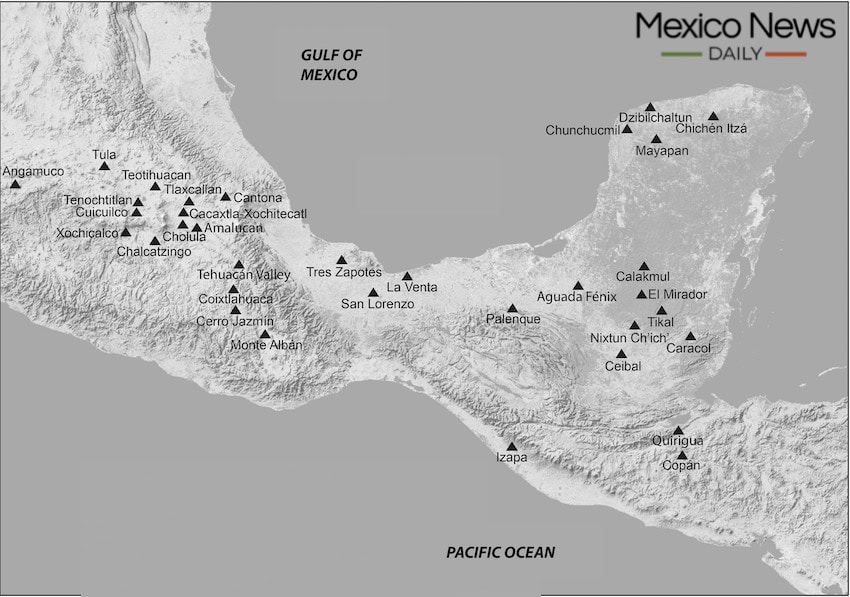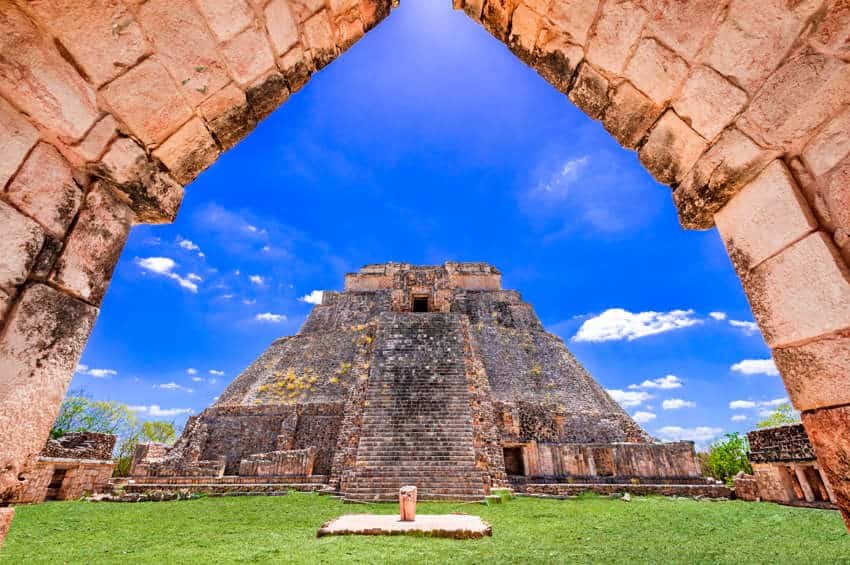For those living in or interested in Mexico, the term “Mesoamerica” is unavoidable: Just look at how often the word comes up in Mexico News Daily.
In June of this year alone, Gabriela Solis told readers that Tenochtitlán — present-day Mexico City — was Mesoamerica’s largest city, Andrea Fischer described how New Age mumbo jumbo is passed off to unsuspecting tourists as ancient Mesoamerican wisdom and Chris Sands recalled the quesadilla’s Mesoamerican roots. But what was — or is — Mesoamerica in the first place?
What is Mesoamerica?

Mesoamerica is a historical cultural area that encompasses the area from what is now central Mexico down to northwestern Costa Rica, spanning all of present-day El Salvador and Belize and the western halves of Honduras and El Salvador. Alongside Iraq, China, India, Egypt and Peru, it is recognized as one of six “cradles of civilization,” or a location where civilization originated independently.
The term “Mesoamerica” — literally “middle America” in Greek — was never used by the region’s ancient inhabitants and is relatively new. It was first coined in 1943 by the German-born anthropologist Paul Kirchhoff, who spent the second half of his life in Mexico, where he helped to found the National School of Anthropology and History (ENAH).
Kirchoff’s definition of the region had to do with language and culture. Mesoamerica’s peoples spoke languages belonging to six major language families — Uto-Aztecan, Totonacan, Oto-Mangue, Mixe–Zoque, Mayan and Chibchan — as well as a handful of other families and some language isolates.
The inhabitants of Mesoamerica also had a long list of shared features in their material and intellectual cultures, and though many features also appeared in cultures outside their area, it was only in this region that they were all brought together. Archaeologists and ethnographers since Kirchhoff have built on and critiqued his original list, but most agree that Mesoamerican cultures shared traits including the following:
Agriculture: The ancient peoples of Mesoamerica domesticated the turkey and dog and cultivated crops including cacao, agave, chia, cotton, chili peppers, tomatoes, avocados and — most importantly — the central trio of corn, beans and squash. They developed agricultural techniques so effective they are still used today, including terrace farming, the “floating gardens” called chinampas and the milpa system, which grows corn, beans and squash simultaneously in the same parcel.
Architecture: From Cañada de la Virgen in Guanajuato to Garrobo Grande in Nicaragua, Mesoamerica is dotted with stepped pyramids, probably the region’s most iconic type of ancient structure. Monumental public plazas and buildings oriented around the movements of the heavenly bodies are also common throughout the region, as are the courts where athletes used rubber balls to played the many variations of what archaeologists call the Mesoamerican ball game.
The calendar: Mesoamerican cultures were skilled in astronomy and developed a dual-calendar system, using a 365-day solar calendar and a sacred 260-day calendar with 13 months of 20 days each, with five inauspicious or unlucky days to complete the 365-day cycle. This system was related to Mesoamerica’s base-20 number system and the fact that 13 was a sacred number in several of the region’s cultures; the Nahuas of central Mexico, for example, believed in 13 heavens. This calendar is still used in some communities across the region: some Maya peoples of Guatemala, for example, train Day Keepers who maintain the sacred calendar for ritual purposes today.
Writing: On tanned deer skins and amate bark paper, Mesoamericans created folding books we now call codices in which they recorded the histories of their city-states and kept extensive tax records. The writing systems of Mesoamerica were diverse, including the logographic systems used by the Maya — in which a symbol represents a sound or word, as with ancient Egyptian hieroglyphs — and pictographic Mixtec writing. Tragically, countless written records were destroyed by the Spanish during the colonial period, but surviving examples continue to shed light on pre-colonization Mesoamerica.

Other common features of Mesoamerican cultures include a polytheistic religion featuring deities representing forces of nature and a feathered serpent god — Quetzalcoatl among the Nahua and Qʼuqʼumatz for the K’iche Maya, for example — ritual execution and self-sacrifice in the form of bloodletting, as well as specialized markets and the use of earrings.
When was Mesoamerica?
For Kirchhoff, Mesoamerica was bounded not only in space but in time, existing from roughly 2500 B.C. to 1521 of the present era. A.D. 1521 marks the fall of Tenochtitlán, the leading city of the Triple Alliance — better known as the Aztec Empire — to the Spanish and their Indigenous allies. Although several Mesoamerican peoples successfully resisted colonization for generations and dozens of cultures have survived to the present day, colonialism marked the end of Mesoamerica as a distinct cultural region in the same way as it had previously been.
Historians and archaeologists divide Mesoamerican history into five main periods. These are the Paleo-Indian, Archaic, Preclassic, Classic and Postclassic, and each is further divided into sub-periods. Mesoamerican civilization properly begins in the Preclassic, with the Paleo-Indian period seeing human beings first arrive in the region, perhaps as early as 30,000 years ago, and live as hunter-gatherers, developing agriculture and leaving the nomadic life behind in the Archaic period between around 8000 and 2000 B.C.
The Preclassic period, falling roughly between 2000 B.C. and A.D. 250, saw social complexity skyrocket and the first flourishing of great civilizations, including the Olmecs of the Gulf Coast, sometimes considered the “mother culture” of other Mesoamerican civilizations. The oldest Mesoamerican writing and calendrical systems appeared during this period.
The monumental city-states that we associate with Mesoamerica emerged during the Classic period, with the most famous example being Teotihuacán, in present-day México state. This city dominated politics and trade in the region for centuries, with its influence stretching as far away as the Maya cities of the Yucatán Peninsula — which also reached the height of their splendor in this period — and its fall around the 7th or 8th century AD created a power vacuum across Mesoamerica.

The post-Teotihuacán void came to be filled by the trading city of Xochicalco and later the Toltecs of present-day Tula, Hidalgo, during the Postclassic period, which lasted from A.D. 900 to 1521. The Toltecs themselves were succeeded by the Mexica (Aztecs), who at the head of the Triple Alliance between the cities of Tenochtitlán, Texococo and Tlacopan achieved control of central Mexico unseen since Teotihuacán. Whatever further consolidation might have happened under the Mexica was shattered by the arrival of the Spanish in Mexico in 1519.
Oasisamerica and Aridoamerica
You may have already noticed that, though extensive, Mesoamerica doesn’t cover all of modern-day Mexico. A great deal of it, in fact, is left out: Most of the territory of the northern border states and all of the Baja California Peninsula fall outside of the region, for example. If this wasn’t Mesoamerica, what was it?
In the 1950s, Paul Kirchhoff answered this question, building off the work he had done a decade earlier. Mesoamerica had two northern neighbors, he wrote: Arid America and Oasis America. These culture regions had essentially been created by the landscape and climate of what is now northern Mexico and the southwestern United States. The former, now called Aridoamerica by archaeologists, was inhabited by peoples like the Wixárika (Huichol), Pai Pai and Yaquis. Aridoamerica’s rough terrain and extreme climate, combined with its lack of rainfall, did not lend itself to sedentism or the consolidation of large political units and made a semi-nomadic hunter-gatherer lifestyle best suited to its environment.
What is now called Oasisamerica, on the other hand, was a cultural region of farmers living in settled villages, an arrangement made possible by the milder climate and more readily available water. It spanned parts of Chihuahua, Sonora, and Baja California, as well as several states of the U.S. Southwest. The modern-day Pueblo and O’odham peoples descend from the cultures of this area, and the cliff dwellings of the U.S. Southwest are among the most striking examples of their architecture. Oasisamericans maintained much stronger links to Mesoamerica than their Aridoamerican counterparts did, farming corn and participating in complex trade networks that brought Arizonian turquoise to central Mexico and scarlet macaws from modern Veracruz to Paquimé, in what is now northwestern Chihuahua.
Mexico News Daily




